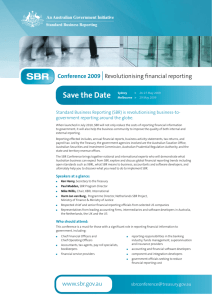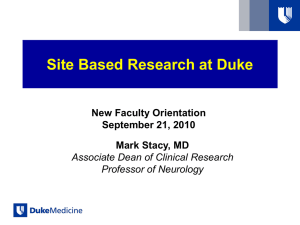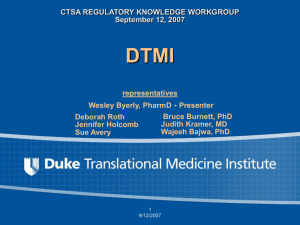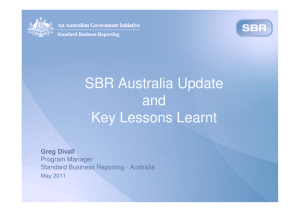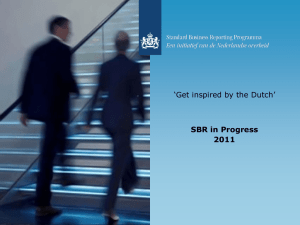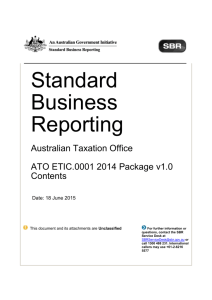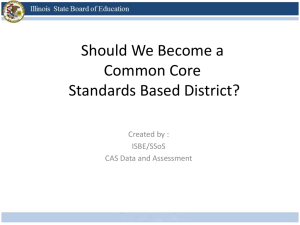Word - 44 Kb
advertisement
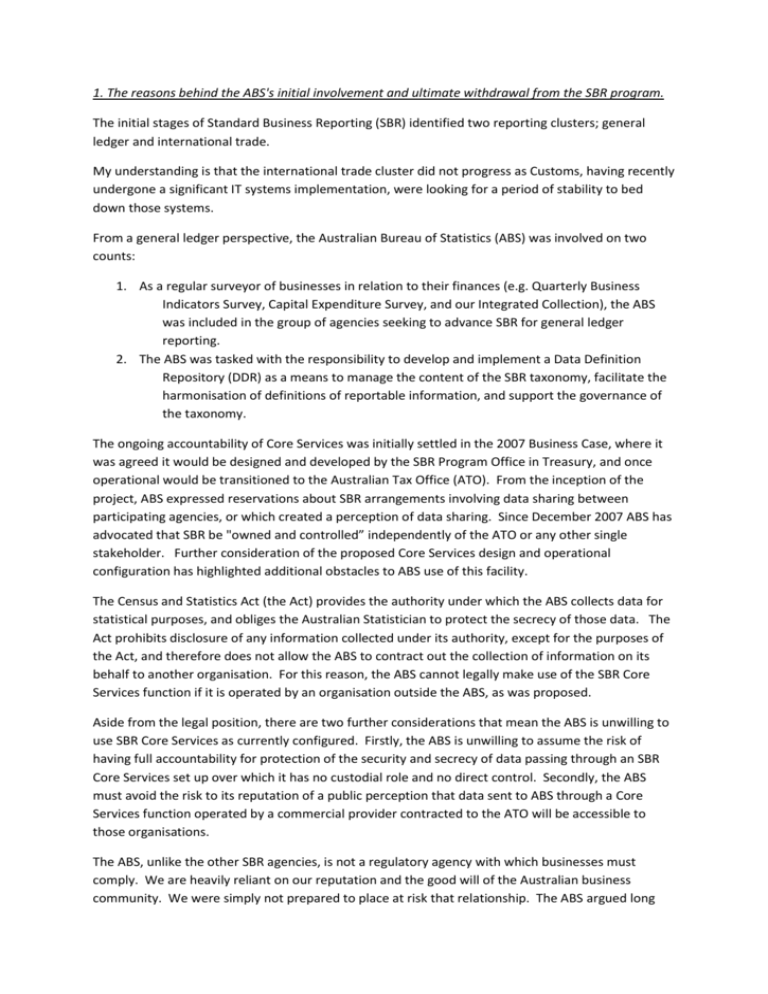
1. The reasons behind the ABS's initial involvement and ultimate withdrawal from the SBR program. The initial stages of Standard Business Reporting (SBR) identified two reporting clusters; general ledger and international trade. My understanding is that the international trade cluster did not progress as Customs, having recently undergone a significant IT systems implementation, were looking for a period of stability to bed down those systems. From a general ledger perspective, the Australian Bureau of Statistics (ABS) was involved on two counts: 1. As a regular surveyor of businesses in relation to their finances (e.g. Quarterly Business Indicators Survey, Capital Expenditure Survey, and our Integrated Collection), the ABS was included in the group of agencies seeking to advance SBR for general ledger reporting. 2. The ABS was tasked with the responsibility to develop and implement a Data Definition Repository (DDR) as a means to manage the content of the SBR taxonomy, facilitate the harmonisation of definitions of reportable information, and support the governance of the taxonomy. The ongoing accountability of Core Services was initially settled in the 2007 Business Case, where it was agreed it would be designed and developed by the SBR Program Office in Treasury, and once operational would be transitioned to the Australian Tax Office (ATO). From the inception of the project, ABS expressed reservations about SBR arrangements involving data sharing between participating agencies, or which created a perception of data sharing. Since December 2007 ABS has advocated that SBR be "owned and controlled” independently of the ATO or any other single stakeholder. Further consideration of the proposed Core Services design and operational configuration has highlighted additional obstacles to ABS use of this facility. The Census and Statistics Act (the Act) provides the authority under which the ABS collects data for statistical purposes, and obliges the Australian Statistician to protect the secrecy of those data. The Act prohibits disclosure of any information collected under its authority, except for the purposes of the Act, and therefore does not allow the ABS to contract out the collection of information on its behalf to another organisation. For this reason, the ABS cannot legally make use of the SBR Core Services function if it is operated by an organisation outside the ABS, as was proposed. Aside from the legal position, there are two further considerations that mean the ABS is unwilling to use SBR Core Services as currently configured. Firstly, the ABS is unwilling to assume the risk of having full accountability for protection of the security and secrecy of data passing through an SBR Core Services set up over which it has no custodial role and no direct control. Secondly, the ABS must avoid the risk to its reputation of a public perception that data sent to ABS through a Core Services function operated by a commercial provider contracted to the ATO will be accessible to those organisations. The ABS, unlike the other SBR agencies, is not a regulatory agency with which businesses must comply. We are heavily reliant on our reputation and the good will of the Australian business community. We were simply not prepared to place at risk that relationship. The ABS argued long and hard for the accountability for Core Services to be placed with an "independent" organisation that had no direct interest, either perceived or real, in the content passing through Core Services. Should such a model be adopted in the future the ABS would certainly reconsider its position. 2. Whether the ABS envisages a use for SBR in the longer term. Absolutely. SBR isn't just a good idea, it’s a great idea. It provides a much more efficient model for the provision of information from business to government. As the Productivity Commission, the Henry Review, and the Moran Review have all advocated, SBR, as it matures, should be extended beyond general ledger reporting. All industries, where there is wide spread adoption of software tools to assist in the management of business operations, are within scope to adopt the SBR model. As the same basic principles of uniform authentication and the transfer of information from software, via a dedicated channel, to government apply, there is similar scope to reduce reporting burden. In addition, the expansion of the SBR taxonomy beyond financial reporting would be of great benefit to government as it would provide an invaluable asset in detailing each agency's information gathering activities, facilitate the rationalisation and harmonisation of those activities, and foster information sharing (of confidentialised data) between agencies. The ABS surveys the entire spectrum of Australian industry - agriculture, mining, wholesale and retail trade, manufacturing, education, banking, transport, health care, etc. The expansion of SBR into other reporting clusters is of interest to us as no doubt industries within those clusters will be the subject of existing ABS survey activities. However I need to stress an earlier point, as SBR expands beyond general ledger reporting it makes less and less sense for the ATO to be the custodians of Core Services. It's simply not their core business (more on that later). 3. The amount of funding that the ABS received from the Commonwealth and what was achieved with this. The initial amount allocated to the ABS over four years was $27.6m 2007/08 $9.197m 2008/09 $8.782m 2010/11 $7.203m 2011/12 $3.262m Total $27.606 2011/12 $5.530m Total $23.421m The ABS returned a total of $23.4m to the SRB Program Office. 2007/08 $4.453m 2008/09 $4.342m 2010/11 $9.096m In preparation for the adoption of SBR the ABS engaged in a number of activities. • The development of ABS taxonomy content. The benefits achieved include better metadata descriptions, the harmonisation of terms between SBR agencies, and better understanding of eXtensible Markup Language (XML) and eXtensible Business Reporting Language (XBRL) standards. • The integration of data sourced from SBR Core Services into the existing ABS IT infrastructure. This included preparations for the passage of information through the ABS firewall, the integration of SBR data into our existing processing systems, establishing links between the new input channel and our provider management system (as a means of managing our respondents), and the creation of metadata systems in support of online survey forms. As an alternative to SBR Core Services, the ABS has leveraged this capability in the development of an online reporting capability for business. • As noted earlier, the ABS was responsible for the development of the SBR Data Definition Repository (DDR). The development of a DDR was somewhat compromised by the level of sophistication required, the general understanding (both within ABS and across the IT industry) of metadata management, and the timeframes available. As a result, a scaled down version of the DDR was delivered and is currently in operation within the SBR Taxonomy Development Team in the ATO. Unused funds were returned to the SBR Program Office. 4. Any thoughts you may have regarding the reasons for the low take-up rates by businesses for SBR so far. The adoption of SBR is predicted on a number of factors including awareness, access, and usability. The absence of any of these 3 will severely impact on the take-up rate for SBR. I suspect all 3, but in particular awareness and access, contribute to the current low take-up rates. It is most likely that people are simply unaware of the presence of SBR, or unable to access it via their existing software packages. Few would have considered the potential and rejected it. The success factor for SBR is reliant on a number of key groups:• • • • • SBR Program Office SBR agencies Businesses Accountant/Bookkeepers Software Developers SBR agencies have a range of pre-existing reporting arrangements. It is incumbent upon them to help make their clientele aware of the existence of SBR and the alternatives it provides. This is somewhat compromised by the patchy adoption of SBR amongst software developers. Ideally agencies, wherever possible, should look to decommission existing systems and transition their existing clients. Software developers have clearly taken a range of approaches to the adoption of SBR; some choosing to become early adopters while others have chosen a watch and see approach. It is a simple fact that a large segment of the business community use software packages that are not currently SBR compliant. In early 2010 the delayed availability of the SBR taxonomy severely limited the capacity for software developers to incorporate SBR into their product release for the 2010/11 financial year. An improvement for 2011 has seen a number of software developers providing SBR compliant software and a resulting increase in take-up. As the pattern of adoption increases the expectation is that the take-up rate will increase. The obvious risk is that current low take-up rates will dissuade software developers from incurring the expense of developing SBR compliant software. I have no effective means of measuring awareness levels within the business community and accounting/bookkeeping industries. The SBR Program Office undertook a very comprehensive stakeholder engagement strategy but I suspect there is still work to be done here. It can also be argued that the take-up figures in the SBR business case were somewhat adventurous. Perhaps the adoption rate of the ATO's Etax product would provide a more realistic set of expectations. 5. Any suggestions you have may have as to possible steps the Commonwealth Government could make to increase take-up rates by business. Following on from my previous point there needs to be improvements in both access and awareness. Obviously a number of software developers are cautious in their approach -–Mind Your Own Business ( M.Y.O.B.) being a major provider that to this point has chosen not to provide SBR compliant software. The demands of their clientele and the actions of their competitors are prime motivators. A decision by M.Y.O.B. to make their software SBR compliant would be a significant step in improving access. However, providing incentives for M.Y.O.B. to make their software SBR compliant would be done at the risk of disenfranchising those who have already undertaken this task in the absence of incentives. There is plenty of scope for SBR agencies to improve take-up rates. On the assumption that the SBR system offers efficiencies to SBR agencies, agencies might consider offering later lodgement dates for clients lodging via SBR. Agencies can also assist in targeting awareness campaigns towards their clients who are currently not using SBR as a reporting channel. In addition, the transition from paper based reporting systems to electronic communications will improve take-up. For example, the ATO currently posts paper forms to clients to check, sign, and return. An alternative strategy to email clients and channel returns via SBR will improve take-up. Further engagement with media and representatives of both the business community and the accounting/bookkeepers industry to raise awareness particularly through the communications of good news stories would be beneficial. Improving the visibility of SBR on government websites will assist in raising the awareness of SBR. For example, the ATO web page which provides instructions on how to complete a Business Activity Statement makes no mention of SBR. Information regarding SBR is not prominently displayed on the www.business.gov.au website.
